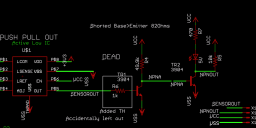2N3904 NPN dead twice.
I have a sensor with push pull output, active low. Marked SensorOut. On the board I accidentally left out a base resistor to the 3904 NPN. I found a convenient point to cut a insert a through hole 1K on the board, and it is soldered from a trace off the sensor to the pad/pin of the base at the 3904. Twice this 3904 has died. I replaced it a few weeks ago, I know the board has been on for many days spread out over several weeks, but yesterday I turned it back on to watch it again and today the NPN is shorted from Base> Emitter with 82ohms reading. My only thoughts are the heat from soldering direct to the pin, but 2 weeks for it to die the second time around?
The circuit basically just allows an NPN buffered output and an LED driver on the low side, inverting the active low out to active high for LED ON. Now the LED is stuck ON.
Any thoughts on this?
The circuit basically just allows an NPN buffered output and an LED driver on the low side, inverting the active low out to active high for LED ON. Now the LED is stuck ON.
Any thoughts on this?



Comments
Double check the connections and resistances from Vcc to collector and GND to emitter on the transistor. I suspect it has nothing to do with the 1K base resistor but with a 49K resistor on the collector you could try a higher value base resistor.
Now when you say that the base emitter is "shorted" you do mean that you have checked this in both directions haven't you? The base will look shorted because it is effectively a diode, so use the diode checker to check base emitter connections. 700mV give or take 100mV in one direction and open in the other.
I suppose that the VCC voltage is 5V or more.
You ENable the sensor with 5V and that is more than the supply voltage.
Do you have a link to the original schematic?